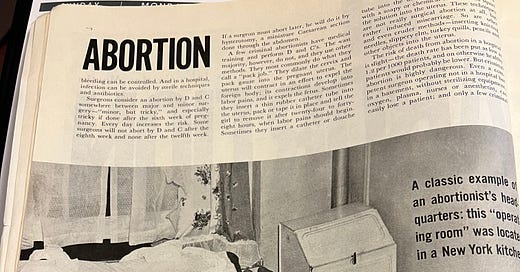A look back at the days of Criminal Abortion
Typical penalty was three years in most state's penal codes
(An inside look at what an abortionist’s facility looked like, as appeared in a three-part investigation by the Saturday Evening Post in 1961)
In 1961, journalist John Bartlow Martin embarked on a trip across America to investigate criminal abortion for the Saturday Evening Post. He went to Los Angeles, where he found a story about Brenda Blonder, a 16-year-old girl who had been killed during a procedure. The “doctor,” who turned out to be a real estate salesman, took her body and dumped it on a hospital lawn. He was later sentenced to prison for involuntary manslaughter.
Bartlow later was part of a police bust of another Los Angeles abortionist who had caused a girl to be hospitalized. Staff at the facility alerted the abortion squad, which was a special unit in many departments that investigated and apprehended people who committed or were accomplices or accessories to abortion. To catch an abortionist, some would use decoys in the form of a woman police officer who would arrange an abortion, go to the facility, and then be followed by male detectives. Others would start a stakeout to document the suspected abortionist’s activities.
Bartlow witnessed the man’s arrest after a cop had called him the night before to arrange an abortion.
At the time, it was illegal in every state except in a few places where it could be performed to save the life of the mother. Between 750,000 to 2 million abortions happened illegally that year, according to some estimates. Roughly 5,000 of them ended fatally for the woman.
It’s useful to depict and show what abortions were like before Roe v. Wade because it in part explains the justices’ reasoning behind the decision. From a criminal standpoint, lawyers argued for uniformity of law–in that some states permitted abortion in all cases while in others there was a criminal penalty for the same procedure in the same circumstances.
The cases were hard to prove, as most relied on testimony from women who had survived. Had the woman died and the body been disposed of, the forensic investigative techniques hadn’t advanced to the point where apprehending a suspect would be done with ease. And even in cases where a man or woman was charged, the jury would often not convict because many of the 12 people convened would have either had an abortion or had paid for one for their girlfriend or wife.
Abortion was never treated as a capital offense either. In Pennsylvania, the penalty was three years and the crime was manslaughter associated with the death of the mother. Fetal personhood had never been acknowledged in any of the 50 commonwealth statutes.
With medical advances like abortion pills, the likelihood that there would be a return to widespread back-alley situations is unlikely. However, in some poorer communities with transportation barriers and without high-speed internet access, there could be a possibility for these types of scenarios to play out again. It’s something worth studying to inform arguments for choice. For a more detailed account of what it was like before Roe, read Leslie Reagan’s When Abortion was a Crime: Women, Medicine and the Law in the United States, 1867-1973.




